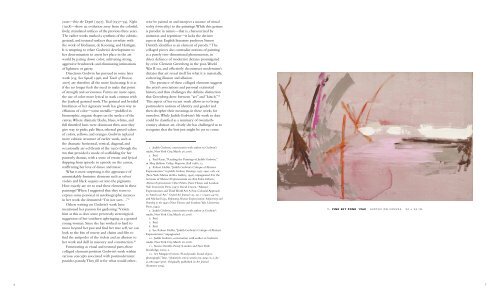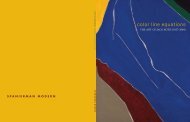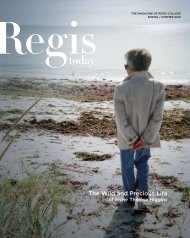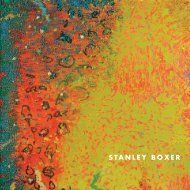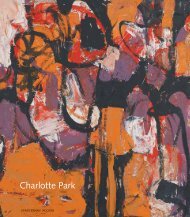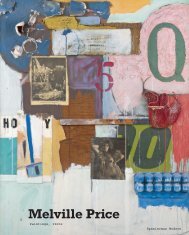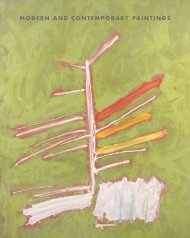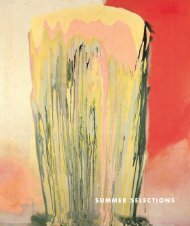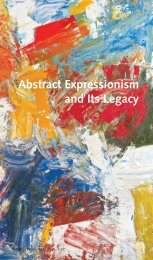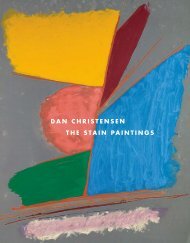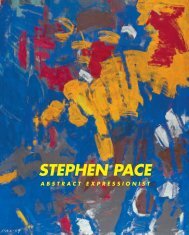View the catalogue as a PDF - Spanierman Modern
View the catalogue as a PDF - Spanierman Modern
View the catalogue as a PDF - Spanierman Modern
- No tags were found...
Create successful ePaper yourself
Turn your PDF publications into a flip-book with our unique Google optimized e-Paper software.
years—Into <strong>the</strong> Depth (1957), Trial (1957–59), Night(1958)—show an evolution away from <strong>the</strong> colorful,lively, crenulated surfaces of <strong>the</strong> previous three years.The earlier works marked a syn<strong>the</strong>sis of <strong>the</strong> cubistic,gestural, and textural surfaces that correlate with<strong>the</strong> work of Hofmann, de Kooning, and Hartigan.It is tempting to relate Godwin’s development toher determination to <strong>as</strong>sert her place in <strong>the</strong> artworld by paring down color; cultivating strong,aggressive brushwork; and eliminating intimationsof lightness or gaiety.Directions Godwin h<strong>as</strong> pursued in some laterwork (e.g. Sea Squall, 1998, and Touch of P<strong>as</strong>sion,2007) are <strong>the</strong>refore all <strong>the</strong> more f<strong>as</strong>cinating. It is <strong>as</strong>if she no longer feels <strong>the</strong> need to make that pointof strength and seriousness. Forms are more open,<strong>the</strong> use of color more lyrical in stark contr<strong>as</strong>t with<strong>the</strong> [earlier] gestural work. The gestural and bristledbrushiness of her signature work h<strong>as</strong> given way toeffusions of color—some metallic—puddled inbiomorphic, organic shapes on <strong>the</strong> surface of <strong>the</strong>canv<strong>as</strong>. Where dramatic blacks, blues, whites, andfull throttled hues were dominant <strong>the</strong>n, now <strong>the</strong>ygive way to pinks, pale blues, e<strong>the</strong>real grayed valuesof colors, yellows, and oranges. Godwin replacedmore cubistic structure of earlier work, such <strong>as</strong><strong>the</strong> dramatic horizontal, vertical, diagonal, andocc<strong>as</strong>ionally arc-ed thrusts of <strong>the</strong> 1950s through <strong>the</strong>80s that provided a mode of scaffolding for herpainterly dram<strong>as</strong>, with a sense of erratic and lyricalskipping from episode to episode on <strong>the</strong> canv<strong>as</strong>,reaffirming her love of dance and music.What is most surprising is <strong>the</strong> appearance ofunmistakably feminine elements such <strong>as</strong> velvetviolets and black sequins set into <strong>the</strong> pigments.How exactly are we to read <strong>the</strong>se elements in <strong>the</strong>sepaintings? When I suggested that <strong>the</strong>y seem toexpress some personal or autobiographic nuancesin her work she demurred: “I’m not sure. . . .” 8O<strong>the</strong>rs writing on Godwin’s work havementioned her p<strong>as</strong>sion for gardening. 9 Violetshint at this <strong>as</strong> does some perversely stereotypicalsuggestion of her sou<strong>the</strong>rn upbringing <strong>as</strong> a genteelyoung woman. Since she h<strong>as</strong> worked so hard tomove beyond her p<strong>as</strong>t and find her true self, we canlook to <strong>the</strong> bits of veneer and chains and files tofind <strong>the</strong> antipodes of <strong>the</strong> violets and an allusion toher work and skill in m<strong>as</strong>onry and construction. 10Functioning <strong>as</strong> visual and textural parts, <strong>the</strong>secollaged elements position Godwin’s work withinvarious concepts <strong>as</strong>sociated with postmodernism:p<strong>as</strong>tiche, parody. They fill in for what would o<strong>the</strong>rwisebe painted on and interject a nuance of virtualreality (virtu-ality) to <strong>the</strong> paintings. While this gestureis parodist in nature—that is, characterized byimitation and repetition—it lacks <strong>the</strong> derisive<strong>as</strong>pects that English literature professor SimonDentith identifies <strong>as</strong> an element of parody. 11 Thecollaged pieces also contradict notions of painting<strong>as</strong> a purely two-dimensional phenomenon, indirect defiance of modernist dictates promulgatedby critic Clement Greenberg in <strong>the</strong> post-WorldWar II era, and effectively deconstruct modernism’sdictates that art reveal itself for what it is materially,eschewing illusion and allusion.The presence of <strong>the</strong>se collaged elements suggests<strong>the</strong> artist’s <strong>as</strong>sociations and personal existentialhistory, and thus challenges <strong>the</strong> definite distinctionthat Greenberg drew between “art” and “kitsch.” 12This <strong>as</strong>pect of her recent work allows us to bringpostmodern notions of identity and gender and<strong>the</strong>n decipher <strong>the</strong>ir meanings in <strong>the</strong>se works forourselves. While Judith Godwin’s life work to datecould be cl<strong>as</strong>sified <strong>as</strong> a summary of twentiethcenturyabstract art, clearly she h<strong>as</strong> challenged us torecognize that <strong>the</strong> best just might be yet to come.1. Judith Godwin, conversation with author in Godwin’sstudio, New York City, March 26, 2008.2. Ibid.3. Paul Ryan, “Reading <strong>the</strong> Paintings of Judith Godwin,”in Mary Baldwin College Magazine (Fall 1988), 13.4. Robert Hobbs, “Judith Godwin’s Critique of AbstractExpressionism,” in Judith Godwin, Paintings: 1953–1992, exh. cat.(New York: Marisa del Re Gallery, 1992), unpaginated. For <strong>the</strong>revisions of Abstract Expressionism see Ann Eden Gibson,Abstract Expressionism: O<strong>the</strong>r Politics (New Haven and London:Yale University Press, 1997); David Craven, “AbstractExpressionism and Third World Art: A Post-Colonial Approachto ‘American’ Art.” Oxford Art Journal 121, no. 1 (1990): 44–65;and Michael Leja, Reframing Abstract Expressionism: Subjectivity andPainting in <strong>the</strong> 1940s (New Haven and London:Yale UniversityPress, 1993).5. Judith Godwin, conversation with author at Godwin’sstudio, New York City, March 26, 2008.6. Ibid.7. Ibid.8. Ibid.9. See Robert Hobbs, “Judith Godwin’s Critique of AbstractExpressionism,” unpaginated.10. Judith Godwin, conversation with author at Godwin’sstudio, New York City, March 26, 2008.11. Simon Dentith, Parody (London and New York:Routledge, 2000), 2.12. See Margaret Iversen, “Readymade, found object,photograph,” http://findarticles.com/p/articles/mi_m045/is_2_63/ai_n6155497/print. Originally published in Art Journal(Summer 2004).2. PINK SKY POND 1960 ACRYLIC ON CANVAS 24 x 36 IN.67


